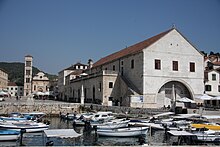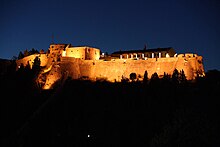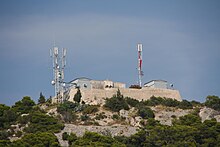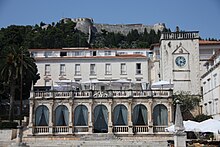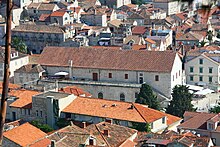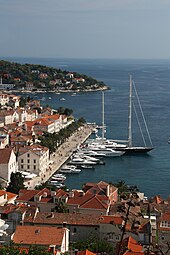Hvar (town)
| Hvar | |||
|
|||
|
|
|||
| Basic data | |||
|---|---|---|---|
| State : |
|
||
| County : |
|
||
| Island : | Hvar | ||
| Height : | 0 m. i. J. | ||
| Area : | 75.50 km² | ||
| Residents : | 4,251 (2011) | ||
| Population density : | 56 inhabitants per km² | ||
| Telephone code : | (+385) 021 | ||
| Postal code : | 21 450 | ||
| License plate : | ST | ||
| Boat registration : | HV | ||
| Structure and administration (status: 2013, cf. ) |
|||
| Community type : | city | ||
| Mayor : | Rino Budrović ( SDP ) | ||
| Postal address : | Fabrika bb 21 450 Hvar |
||
| Website : | |||
| Others | |||
| Patron saint : | Stephan I (Bishop of Rome) | ||
| City Festival : | August 2nd | ||
Hvar [ ˈxʋǎːr ] (In the local Croatian dialect : Hvor or For , Greek : Pharos , Latin : Pharina , Italian Lesina ) is a town and port on the island of Hvar in Split-Dalmatia County , Croatia . The city is the seat of the Catholic diocese of Hvar . In 2011, the population of the entire municipality of Hvar was 4,251 people and the city itself was 3,771. This makes it the largest city on the island. It is located in a bay on the south side of the island, opposite the towns of Stari Grad and Jelsa . The town of Hvar also includes the suburbs Brusje, Jagodna, Malo Grablje, Milna, Sveta Nedjelja, Velo Grablje and Zaraće.
City structure
The town of Hvar is divided into eight districts:
| District | Population 2001 |
Population 2011 |
|---|---|---|
| Brusje | 216 | 194 |
| Hvar | 3,772 | 3,771 |
| Jagodna | 30th | |
| Malo Grablje | 0 | 0 |
| Milna | 91 | 104 |
| Sveta Nedjelja | 157 | 131 |
| Velo Grablje | 21st | 7th |
| Zaraće | 1 | 14th |
| Hvar town | 4,258 | 4,251 |
geography
The town is located in a small bay on the south coast near the western end of the island of Hvar. It is surrounded by karst hilly land that rises steeply from the Adriatic Sea . In front of the port of Hvar are the Hell Islands ( Pakleni Otoci ).
Since the soil consists mainly of limestone and dolomite , groundwater is rare. Where the soil conditions allow, olives , wine , lavender and rosemary are grown for agriculture.
The mountain range, which stretches the length of the entire island, forms a natural barrier between the settlements on the north coast and the south coast. With the construction of a road tunnel in 2000, the connection to the Stari Grad ferry port was significantly shortened.
climate
Typically for the southern Adriatic, Hvar has a Mediterranean climate with mild, humid winters and dry, hot summers. In the winter months the average daily temperature is 12 to 13 ° C, in summer it rises to 28 to 29 ° C. At night the values drop to 5 to 7 ° C in winter and 20 to 21 ° C in summer. During the summer months, a steady westerly wind brings coolness during the day. Rain is rare in spring and summer, but abundant in autumn and winter. Snowfall is extremely rare (on average once every 10 years). The water temperature averages 20 ° C from June to October, but temperatures of up to 27 ° C are not unusual.
history
Due to the favorable nautical location of the Hvar harbor, the city has always been in the interests of various powers. There is evidence of an Illyrian settlement as early as the 1st millennium BC , which stretched along the ridge north of today's town square. In the 4th century BC Chr. Established Syracusan Greeks a settlement.
From the 2nd to 4th centuries there was a small Roman settlement with a harbor on the bay, which was later filled up to form the town square. In the 6th and 7th centuries, Hvar ( Lisina ) was an important military port of call with town and fortress in the area of the Venetian Dalmatia. But between the 8th and 13th centuries, Hvar ( Lesna ) became deserted again and there was only one Benedictine abbey of St. Mary. From the 11th century, Hvar belonged to the Croatian state.
From 1278 to 1797 Hvar was under Venetian rule and experienced its most important period. The diocese of Hvar comprised the islands of Hvar, Brač and Vis . In 1420 the expansion of the city fortifications began and Hvar became the island's capital in place of Pharos . It became the most important Adriatic port and transit center. The city experienced a cultural heyday and received its present urban form. Numerous poets, playwrights, historians and theologians lived and wrote in Hvar, and in 1612 the first popular theater was opened in the newly built arsenal .
Hvar has been the scene of clashes between the middle class and the nobility over the centuries . These reached their peak between 1510 and 1514, when numerous noble families were expelled from the city for years. The unrest was always stifled by Venetian intervention and only Prince Pietro Semitecolo succeeded in establishing a lasting peace from 1611.
From 1797 on, the island and town came under the rule of the House of Habsburg , only to be added to the Empire of Austria and Austria-Hungary again after the Napoleonic Wars from 1813 to 1918 . After the First World War , Hvar was under Italian rule for a short time, after which the city belonged to the Kingdom of Yugoslavia from 1921 to 1941 . From the end of World War II it was part of the Federal People's Republic of Yugoslavia and since 1991 it has been part of the Republic of Croatia .
economy
In earlier centuries the economic success of Hvars v. a. on its position as a conveniently located port in the Adriatic Sea, this changed in 1866 when the Austrian doctor Franz Unger visited the island and found that the climate had a beneficial effect on people with lung disease. Two years later, the then Bishop Juraj Duboković and other respected citizens founded the Hvar Hygienic Society to promote health tourism. Similar initiatives were only slowly emerging in Europe at the time. From these beginnings, tourism developed over the next 140 years as the most important branch of the economy and a fashionable holiday resort emerged. At the beginning of the 21st century, the city of Hvar was able to book over half a million overnight stays a year. Hvar is also popular with nudists , as the island of Jerolim and Stipanska Bay have been reserved for them since the 1920s .
Culture
Annual events in Hvar are:
- The cross procession , a Catholic Easter custom. It has been taking place on Maundy Thursday evening for around 500 years .
- The city festival, which is celebrated on August 2nd on the birthday of city saint Stephan .
Attractions
Fortifications
- Fortress Španjola or Fortica
There is evidence of Illyrian defenses on the mountain north of the city from the first half of the first millennium BC. And a late antique Byzantine fortification. Byzantine traces, probably from the reign of Emperor Justinian , can still be seen on the southern walling.
The construction of the fortress as it can be seen today began in 1282 under the Venetian government. The funds for the construction brought the city largely the income from the salt trade . The construction was not completed until 1551, as evidenced by the year with the Venetian national coat of arms and the city coat of arms above the southern main gate. It probably owes its name Španjola (Spanish fortress) to the fact that Spanish army engineers were also involved in the construction in the 14th century. The complicated architectural scheme, as it can still be seen today, was due to the difficult terrain. Originally there were four round towers, buildings for storage of gunpowder , cisterns , a prison, a small John the Baptist consecrated chapel u. a. When the Turks attacked, looted and pillaged the town on August 19, 1571, almost all of the people of Hvar managed to flee into the fortress and escape. But as early as October 1, 1579, lightning struck the building in which the gunpowder was stored, resulting in an explosion and severe damage to the fortress and renewed partial destruction of the city.
Up until the second half of the 19th century, the facility was continually expanded and repaired. Under Austrian rule, the fortress served as a barracks . When the town of Hvar lost its military importance, the Španjola was abandoned and neglected. Extensive measures to maintain the facility were not carried out until 1971.
- Napoleon fortress
On the mountain east of the Španjola fortress up to 228 m. ü. NN rises, a chapel has stood since the Middle Ages , which is dedicated to St. Nicholas as the patron saint of seafarers . A small fortress was built here in 1811 under Napoleonic occupation as an ideal observation post over the sea. This fortress still bears the name Napoleon to this day and now houses an observatory of the geodetic faculty of the University of Zagreb .
- Baterija fortress
Under French rule, a small fortress was built on the Križni rat ( Cape Cross ) in 1811 to secure the Hvar harbor from the south-east. Under Austrian rule, the complex was named Baterija Andreas Hofer in memory of the Tyrolean freedom fighter who was executed in 1810 , now only called Baterija . The complex is largely in ruins .
- Veneranda fortress
The west side of the port of Hvar is dominated by the mountain Sveta Katarina ( Saint Catherine ). A monastery dedicated to Saint Veneranda existed at this site until 1807 . Also in 1811 the complex was expanded into a fortress. Today the site is used for cultural events.
- Gališnik island
The island in the middle of the entrance to the port was given a fortress in 1831. But after the naval battle of Lissa near today's island of Vis in 1866, the complex was abandoned.
The town
- Pjaca town square
The Pjaca is the center of Hvar and was designed in 1449. The square, which is open to the lake, is surrounded by the city's most important buildings. On the Pjaca , which was paved in 1780, there is a fountain and a stone column that was erected in 1446.
- The loggia
A first palace was mentioned as early as 1289, but under Venetian rule it was rebuilt on the north side of the town square in the 15th century in the typical Renaissance style. The loggia is attributed to the Veronese architect Michele Sanmicheli and masters from Korčula . It was originally a community palace and served as a courthouse. In 1870 it was converted into a coffeehouse for high society
- The arsenal with the theater
The arsenal , built in 1579 directly on the pier on the south side of the town square in place of an older building, was originally a huge shipyard hall for the time . A complete war galley could find space in it. On the first floor, Prince Pietro Semitecolo opened the first public theater in the Balkans in 1612 . On the north side of the arsenal , a terrace, the so-called Belvedere , served the theater. The interior of the theater is furnished according to the Italian model. Croatia has a rich theatrical tradition, which was shown in performances during Carnival time in the city squares, churches and the Prince's Palace. After centuries of disputes between the middle class and the nobility, Prince Semitecolo succeeded in establishing peace between the conflicting parties. The people and landowners alike were allowed to enter the theater and so the words "anno secvndo pacis MDCXII" ( In the second year of peace ) were carved over the entrance door . The theater's authors were Mikša Pelegrinović , Hanibal Lucić , Petar Hektorović , Martin Benetović , Marin Gazarović and others. The theater existed until 1796 (one year before the fall of Venice). After that it was closed and the building served as a barracks. In 1803 the theater was reopened and in 1900 it was restored.
- The bishop's court
The bishop's court was built in 1249 under Bishop Nikolaus. From then until today the Hvar bishops resided in it. Destroyed by the Turks during an attack in 1571, it was rebuilt by Bishop Cedulim at the end of the 16th century.
- The quay ( Molo )
The harbor quay, which was built in 1455, is mainly made of marble . Every city dweller at the time (regardless of their status) had to help with its construction for a day. Its east side was called Molo Vivaldi in earlier times . The quay was last renewed in 1795.
- The Mandrač
The 15th century Mandrač is the safe area of the port. It is surrounded by a stone wall and served the ships as protection from storms
- The wells
The numerous wells in Hvar are remarkable , some of which were built in the 15th century.
Churches and monasteries
- Cathedral of Sv. Stjepan
The cathedral, dedicated to St. Stephen I , dominates the Hvar town square. It represents a combination of Renaissance and Baroque . Originally dating back to the second half of the 13th century, when the diocesan headquarters were moved from Stari Grad to Hvar, it was built in the 16th century on the foundations of an earlier Benedictine monastery . The 17th century bell tower was made by local masters. The inside holds u. a. the Madonna and Saints by Jacopo Palma the Younger and a Pietà by Juan Boschetus .
- Church of Sv. Marko
The Church of Saint Mark was first mentioned in 1326. There are numerous tombs of the nobility in it. In 1808 it was given up. Today it is in ruins and serves as a space for cultural events.
- Franciscan monastery
The Franciscan monastery on the Sridnji rat peninsula dates from the 15th century. The church, consecrated to the Madonna of Mercy , was built with donations from the shipowners who were in the port when Pietro Soranzo , the then captain of the Venetian Navy on the Adriatic, survived a shipwreck in 1465. The Venetian government took the Church under its protection and it became the Church of the Sailors. The portal of the church is the work of Niccolo Fiorentino . In the monastery is the most valuable painting of Hvar, The Last Supper by the Venetian artist Matej Ponzoni-Pončun from the 17th century. In front of the main altar is the grave of Hanibal Lucić .
- Benedictine monastery
The church and monastery were built in the 17th century next to Hanibal Lucić's summer residence from 1530. Today it is in ruins and the residence houses a museum in honor of the poet.
literature
- Moro A. Mihovilović: Otok Hvar. Matica Hrvatska, Zagreb 1995
- Josip Bilić: Turistički vodić.
- Biseri Jadrana: Otok Hvar.
- Božidar Feldbauer: Leksikon naselja Hrvatske. Mozaik knjiga, Zagreb 2004
- Grga Novak: Hvar kroz stoljeća. Narodni odbor općine Hvar, Zagreb 1960




